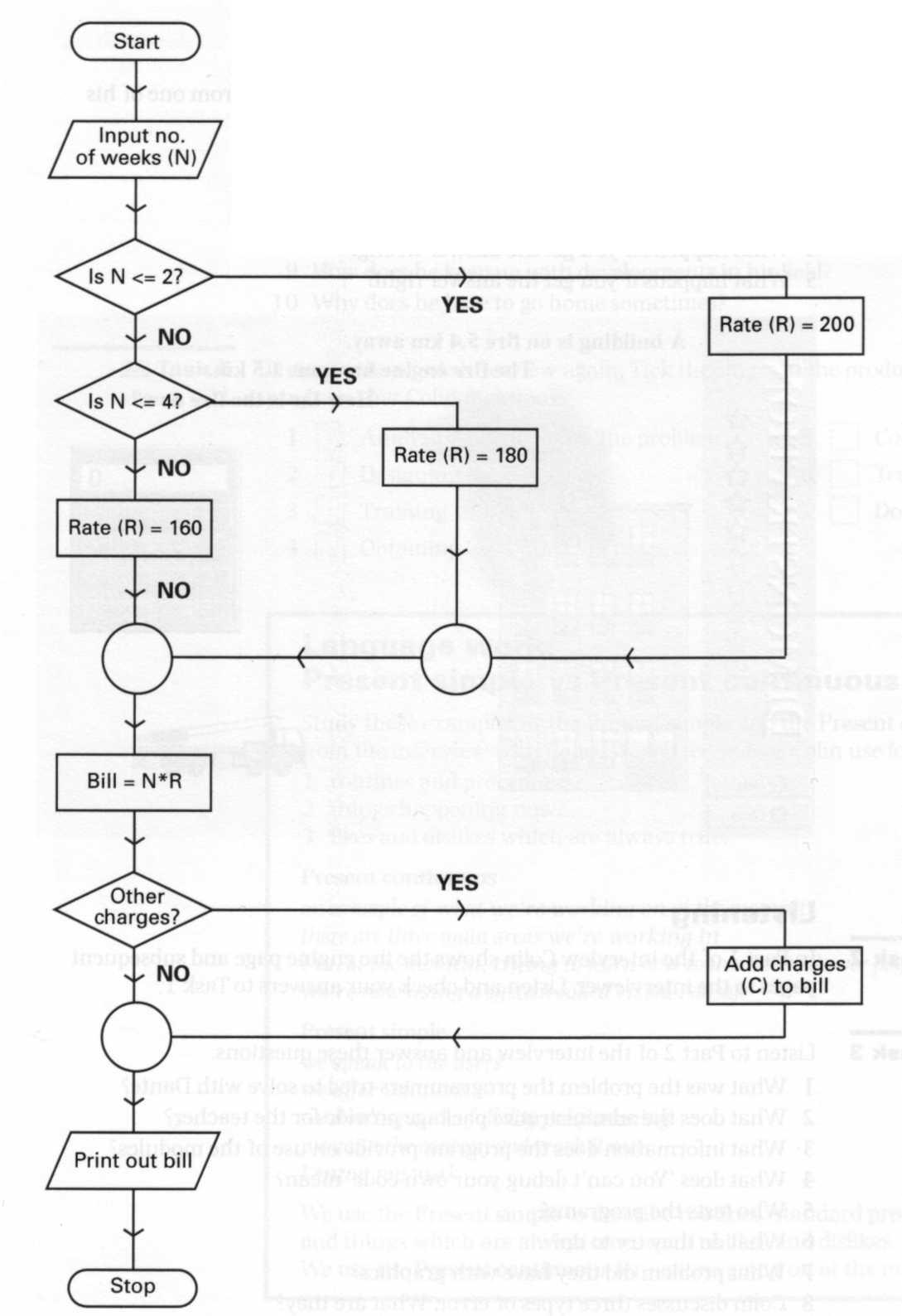
Basic English for Computing / Basic English for Computing (Units) / UNIT 19
.doc19 Programming
Tuning-in
Task 1 Work in pairs. The stages in programming (1-7) are listed below. Fill in the gaps with the missing stages (a-d).
1 Analysing and defining the problem to be solved
2 ____________________
3 Coding
4 ___________________
5 ___________________
6 ___________________
7 Obtaining feedback from users
a Training the users
b Testing
с Designing the program
d Documenting
Task 2 Look at stage 1 of the list in Task 1. Discuss how you would analyse and define the problem. Compare your ideas with other students in the class.
Listening: Flowcharts
Task 3 Programmers sometimes use flowcharts when planning a program.
Listen to Part 1 of the recording to identify these symbols used in flowcharts.

Task 4 Listen again to Part 1. This time write in each symbol a typical example of an instruction often found there in flowcharts. Remember that one symbol has no words.

Reading: Types of error
Task 6 Work in groups of three. Read one of the texts below and complete this table.
When you have finished, exchange information with the others in your group to complete two similar tables.
|
Type of error |
|
|
Definition |
|
|
Example |
|
|
Ways to avoid or deal |
|
|
with this kind of error |
_______________________________ |
|
Text A |
System errors affect the computer or its peripherals. For example, you might have written a program which needs access to a printer. If there is no printer present when you run the program the computer will produce a system error message. Sometimes a system error makes the computer stop working altogether and you will have to restart the computer. A sensible way of avoiding system errors is to write code to check that peripherals are present before any data is sent to it.Then the computer would warn you by a simple message on the screen, like 'printer is not ready or available'. |
|
Text В |
Syntax errors are mistakes in the programming language (like typing PRNIT instead of PRINT). Syntax errors cause the program to fail. Some translator programs won't accept any line that has syntax errors. Some only report a syntax error when they run the program. Some languages also contain special commands such as debug, which will report structural errors in a program.The programming manual for the particular language you're using will give details of what each error message means. |
|
Text С |
Logic errors are much more difficult to detect than syntax errors. This is because a program containing logic errors will run, but it won't work properly. For example, you might write a program to clear the screen and then print 'hello'. Here is a code for this: 10// Message 30 CLS 20 PRINT'Hello' 40 END. The code has a logic error in it, but the syntax is right so it will run. You can get rid of logic errors from simple programs by 'hand-testing' them or doing a 'dry run' which means working through each line of the program on paper to make sure it does what you want it to do. You should do this long before you type in the code. |

|
Language work: Problem and solution |
|
Study these ways of linking a problem and a solution.
Problem: get rid of logic errors Solution: hand-test the program
You can get rid of logic errors by hand-testing the program. To get rid of logic errors, hand-test the program. |
Task 7 Match these problems and solutions. Link them following the examples above.
|
Problems |
Solutions |
|
1 connect a computer to a telephone line 2 identify items for pricing 3 add extra facilities to a computer 4 get more file storage space 5 find syntax errors 6 avoid marking the surface of a CD-ROM 7 improve the speed of your computer 8 avoid system errors 9 prepare a new disk for use 10 transfer information between |
a write code to check a peripheral is present before any data is sent b use the debug command с add more memory d format the disk e use a removable disk f install an expansion card g install a modem h fit a bigger hard disk i use barcode labels j hold it by the edges |
Task 8 Suggest solutions to these problems. Then link the problem and your solution.
1 Make sure there are no viruses on a floppy disk.
2 Prevent unauthorized access to a network.
3 Avoid the risk of losing data.
4 Avoid eye-strain when using computers.
5 Avoid back problems when using computers.
Problem-solving
Task 9 Draw a flowchart for one of these activities. Then compare your completed flowchart with other students in your group.
• using a payphone
• planning a holiday
• choosing a new computer
• preparing for an important exam
Writing
Task 10 Read this description of the flowchart on page 78-9. Then write your own description of the flowchart below.
|
A 'Start' symbol indicates where the program begins. When the program has started, the initial cost of the item is input. A decision is then taken on which rate of tax to use.This depends on the initial cost. If the cost is greater than 100, the program follows the 'Yes' route and sets the tax rate at 15%. Otherwise the program follows the 'No' route and sets the tax rate at 10%.The two different paths then come back together at the 'connector' symbol and follow the same route.The actual sales tax is now calculated by multiplying the cost by the tax rate. Finally the amount of tax is printed out and the program stops. |

